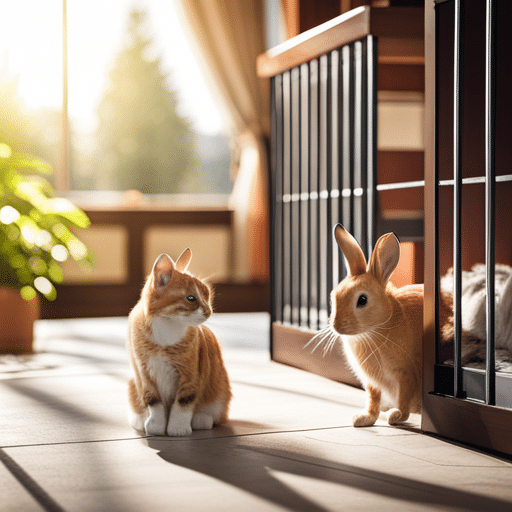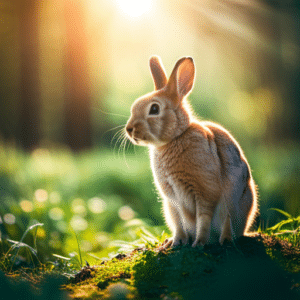In a world where differences often divide us, there is something truly magical about an unlikely friendship. One such bond that has captivated the hearts of many is the dynamic relationship between a cat and a rabbit. These two seemingly incompatible creatures have formed a connection that challenges our preconceived notions and reminds us of the power of acceptance and companionship. Despite their different species and instincts, cats and rabbits have found common ground, proving that friendship knows no boundaries. This intriguing alliance not only defies expectations but also offers a fascinating insight into the complexities of animal behavior. Join us as we delve into the extraordinary world of inter-species friendships and unravel the secrets behind the unique bond shared by cats and rabbits. Prepare to be amazed and inspired by the unlikely friendship that has warmed the hearts of many and reminds us that love and friendship can flourish in the most unexpected places.
The Characteristics of Cats and Rabbits

Cats and rabbits, two animals’ personalities though belonging to different species, share some intriguing similarities and differences. Let’s explore their characteristics to better understand why these two animals might form such a strong bond.
Cats are known for their independent and solitary nature. They are natural predators, with sharp claws and teeth, and possess a keen sense of curiosity. On the other hand, rabbits are generally social and prey animals. They have powerful hind legs for jumping and rely on their acute hearing to detect potential danger. Despite these differences, both cats and rabbits are territorial and have a strong need for a safe and secure environment. This commonality could be a contributing factor to their unlikely friendship.
However, it’s important to note that not all cats and rabbits will automatically get along. Each animal has its unique personality and temperament, which can influence their compatibility and ability to form a bond. Understanding the individual traits of cats and rabbits is crucial in creating an environment where their friendship can flourish.
Understanding the Reasons Behind Their Friendship
The friendship between a cat and a rabbit may initially seem unlikely, but there are several reasons why these animals can form a strong bond. One of the main factors is their complementary nature. While cats are natural hunters, rabbits are prey animals. This contrast in instincts can create a sense of balance in their relationship. Cats may feel a sense of protection and companionship when they are around rabbits, while rabbits may find comfort in having a watchful feline presence that helps them feel safe.
Another reason behind their friendship is the power of companionship. Both cats and rabbits are social animals, though they express it in different ways. Cats often seek companionship from their human owners and can form deep bonds with other animals. Rabbits, too, thrive on social interaction and can benefit from having a companion to share their lives with. When a cat and a rabbit come together, they fulfill each other’s need for companionship, resulting in a mutually beneficial friendship.
The third reason is the element of novelty. Cats are naturally curious creatures, and the presence of a rabbit can pique their interest. The rabbit’s movements, behavior, and unique scent can intrigue a cat’s prey drive, and create a sense of fascination. This curiosity can lead to a gradual acceptance and a bond that transcends their differences.
Benefits of Having a Cat and Rabbit as Companions

Having a cat and a rabbit as companions offers numerous benefits for both the animals and their owners. Let’s explore some of the advantages of this unlikely friendship.
1. Companionship: Cats and rabbits are social animals that thrive on companionship. By having each other as companions, they can provide the social interaction and emotional support that is vital for their well-being.
2. Reduced Stress: Interacting with animals has been proven to reduce stress levels in humans. The presence of a cat and a rabbit can create a calming environment, promoting relaxation and a sense of well-being.
3. Enrichment: Cats and rabbits have different play styles and behaviors. When they interact with each other, they offer mental and physical stimulation, keeping each other entertained and engaged. This enrichment can prevent boredom and promote a healthy lifestyle for both animals.
4. Learning Opportunities: Owning a cat and a rabbit together can provide a unique learning experience. Observing their interactions and understanding their behaviors can offer valuable insights into animal communication and behavior, fostering a deeper appreciation for the animal kingdom.
5. Unconditional Love: Cats and rabbits have a way of bringing joy and unconditional love into our lives. Their friendship reminds us of the beauty of acceptance and the power of love, teaching us valuable life lessons along the way.
Having a cat and a rabbit as companions can truly enrich our lives and create a bond that transcends species. It’s important to remember that each animal has individual needs and personalities, so careful consideration should be given to their compatibility before bringing them together.
Tips for Introducing a Cat to a Rabbit
Introducing a cat to a rabbit requires patience, preparation, and a gradual approach. Here are some tips to help ensure the adult cat has a smooth introduction:
1. Create Separate Spaces: Before bringing the cat and the new rabbit in together, it’s essential to create separate spaces for each animal. This will allow them to adjust to their new surroundings and establish their territories.
2. Scent Exchange: Start by exchanging scents between the cat and rabbit. Rub a cloth on one animal and place it near the other animal, allowing them to become familiar with each other’s scent. This process helps to create a sense of familiarity and reduces the potential for aggression.
3. Supervised Interaction: Once the animals have become accustomed to each other’s scents, you can slowly begin supervised interactions. Keep the initial interactions short and gradually increase the duration over time. Use a barrier, such as a baby gate or a mesh divider, to create a physical barrier while allowing visual and olfactory contact.
4. Positive Reinforcement: Reward both the cat and rabbit with treats and praise during their interactions. This positive reinforcement helps to associate each other’s presence with positive experiences, creating a sense of comfort and acceptance.
5. Gradual Introductions: As the cat and rabbit become more comfortable with each other, you can gradually increase their interaction time. Eventually, you can remove the physical barrier that cats and rabbits get and allow them to interact freely under supervision.
6. Monitor Body Language: Pay close attention to the body language of both animals during their interactions. Signs of fear, aggression, or stress should be taken seriously, and the animals should be separated if necessary. Seek the guidance of a professional animal behaviorist if you encounter any difficulties.
By following these tips and taking a gradual approach, you can increase the chances of a successful introduction between a cat and a rabbit, setting the foundation for a harmonious and lasting friendship.
Tips for Maintaining a Harmonious Relationship Between a Cat and a Rabbit
Once a cat and a rabbit have been successfully introduced, it’s important to maintain a harmonious relationship between them. Here are some tips to help you foster a positive and peaceful bond:
1. Provide Individual Spaces: Each animal should have their own private space where it can retreat and feel safe. This could be a cage, a separate room, or a designated area within a shared space. Having individual spaces ensures that both the cat and rabbit have their own space and a sense of security and ownership.
2. Supervision and Separation: Even after the initial introduction, it’s important to supervise their interactions, especially during the early stages of their friendship. If you need to leave them alone, ensure they are separated to prevent any potential conflicts or accidents.
3. Respect Boundaries: Cats and rabbits have different play styles and communication methods. It’s crucial to respect their boundaries and not force interactions. Allow them to interact on their terms and provide ample opportunities for individual play and exploration.
4. Enrichment and Play: Engage both the cat and rabbit in interactive play sessions to keep them mentally and physically stimulated. Provide toys, scratching posts, and hiding spots for the cat, and toys, tunnels, and chew toys for the rabbit. This enrichment helps prevent boredom and redirects their energy towards positive outlets.
5. Routine and Predictability: Establish a routine that includes regular feeding times, play sessions, and quiet times. Cats and rabbits thrive on predictability, and a consistent schedule helps them feel secure and reduces anxiety.
6. Healthcare and Hygiene: Ensure that both pets, the cat and rabbit receive regular veterinary care. Keep their living areas clean and provide appropriate litter boxes for both animals. Maintaining their health and hygiene is essential for their overall well-being and helps prevent any potential conflicts.
By following these tips and providing pet rabbits with a nurturing environment, you can foster a harmonious and loving relationship between a cat and a rabbit, ensuring a lifetime of friendship and companionship.
Real-Life Stories of Cat and Rabbit Friendships
The world of pets here is filled with heartwarming stories of cat and rabbit friendships. Let’s explore some real-life examples that showcase the remarkable bond between these two unlikely companions:
1. Luna and Bunny Benjamin: Luna, a playful tabby cat, and bossy bunny Benjamin, a gentle Holland Lop rabbit, became fast friends when they were brought together in a loving home. They spend their days chasing each other, grooming, and cuddling. Their friendship is a testament to the power of acceptance and love.
2. Oliver and Thumper: Oliver, a mischievous ginger cat, and bunny friend Thumper, a curious English Angora rabbit, have formed an inseparable bond. They spend hours exploring their surroundings, playing hide-and-seek, and keeping each other company. Their friendship is a constant source of joy and entertainment for their human family.
3. Tiger and Snowball: Tiger, a protective Maine Coon cat, and his friend Snowball, a shy Netherland Dwarf rabbit, share a deep bond that defies their differences. Tiger acts as Snowball’s guardian, ensuring their shared space is safe and secure. Snowball, in return, provides companionship and a calm presence that helps Tiger unwind after a long day of play.
These heartwarming stories remind us that friendship can transcend species and that love knows no boundaries. The bond between a cat and a baby rabbit is a beautiful testament to the power of acceptance, compassion, and magic that can be found in unexpected places.
Common Challenges and How to Overcome Them
While the friendship between a cat and a rabbit is undoubtedly heartwarming, it can also come with its fair share of challenges. Here are some common challenges and tips on how to overcome them:
1. Predatory Instincts: Cats have a natural hunting instinct, which can pose a challenge when introduced to a rabbit. It’s crucial to provide a safe and secure environment for both animals and closely monitor their interactions. Gradual introductions and positive reinforcement can help mitigate any predatory behavior.
2. Territorial Behavior: Both cats and rabbits are territorial animals, and conflicts can arise when their territories overlap. Providing individual spaces and ensuring each animal has its resources, such as food and litter boxes, can help prevent territorial disputes.
3. Communication Barriers: Cats and rabbits communicate in different ways, which can lead to misunderstandings. It’s important to learn and understand the body language and vocal cues of both animals to ensure effective communication and prevent any potential conflicts.
4. Allergies: Some individuals may be allergic to either cats or rabbits, which can pose a challenge when considering their friendship. It’s essential to assess any potential allergies before bringing the animals together and take necessary precautions to minimize exposure.
5. Health Concerns: Cats and rabbits have different dietary and healthcare needs. It’s important to provide appropriate nutrition and veterinary care for both animals to ensure their overall health and well-being. Regular check-ups and vaccinations are crucial for maintaining good health.
By being aware of these challenges and taking proactive measures, you can create a nurturing environment where a cat and a pet rabbit, can thrive and develop a strong and lasting friendship.
Creating a Safe and Enriching Environment for Both the Cat and the Rabbit

Creating a safe and enriching environment in house rabbit society is vital for the well-being of both the cat and the rabbit. Here are some tips to help you provide a nurturing space for these unlikely best friends too:
1. Separate Living Areas: Each animal should have its own designated living area to retreat to when needed. This could be a separate room or a sectioned-off area within a shared space. Ensure that each area is equipped with all the necessary resources, including food, water, litter boxes, and hiding spots.
2. Vertical Space: Cats love to climb and explore their environment vertically. Provide vertical spaces, such as cat trees or shelves, for the cat to climb and observe their surroundings. This not only satisfies their instincts but also allows them to have their territory.
3. Hiding Spots: Both cats and rabbits benefit from having hiding spots where they can retreat when they feel overwhelmed or need some alone time. These hiding spots can be as simple as cardboard boxes or tunnels, providing a sense of security and peace.
4. Enrichment Toys: Engage both the cat and rabbit in interactive play sessions with appropriate toys. Cats enjoy toys that mimic prey, such as feather wands or interactive puzzle toys. Rabbits enjoy toys that encourage digging, chewing, and tossing, such as tunnels, chew toys, and balls. These toys provide mental and physical stimulation, preventing boredom and promoting a healthy lifestyle.
5. Secure Boundaries: Ensure that the living area and house rabbit are escape-proof and safe for both animals. This includes securing windows and doors, covering any exposed wires or cords, and removing any toxic plants or substances that could be harmful to either the cat or the rabbit.
6. Routine and Predictability: Establish a routine that includes regular feeding times, play sessions, and quiet times. Cats and rabbits thrive on predictability, and a consistent schedule helps them feel secure and reduces anxiety.
Creating a safe and enriching environment for both the cat and the rabbit sets the foundation for a harmonious and fulfilling friendship. By understanding their individual needs and providing appropriate resources, you can ensure the well-being and happiness of both animals.
Common Question
Can a cat and a rabbit get along?
Yes, cats and rabbits can get along if the proper steps are taken. Through careful introduction, providing ample space and resources, environmental enrichment, and routine predictability, cats, and rabbits can form strong bonds of friendship. With patience on both sides, many cats, and rabbits have the potential to be great companions!
Do rabbits love cats?
Rabbits can form strong bonds of friendship with cats, but it’s important to note that every rabbit is different. Some rabbits may feel more comfortable around cats than others, so it’s important to observe the behavior of both animals and make sure everyone involved feels safe and secure.
Is there such a thing as a cabbit half cat half rabbit?
No, there is no such thing as a cabbit. A cabbit is a hybrid creature that combines the characteristics of both cats and rabbits, but these creatures do not exist in nature. There are some cat breeds, such as the Pixie-bob and Bengal, which have fur patterns that resemble those of rabbits, but they are still purebred cats.
Conclusion: The Beauty of Unexpected Friendships Between Animals
The unlikely friendship between a cat and a rabbit is a testament to the power of acceptance, compassion, and magic that can be found in unexpected places. Despite their different species and instincts, cats and rabbits have formed a bond that defies expectations and reminds us of the beauty of friendship. Their friendship teaches us valuable life lessons about the importance of acceptance, understanding, and the power of love.
By understanding the characteristics of cats and rabbits, the reasons behind their friendship, and the benefits of having them as companions



